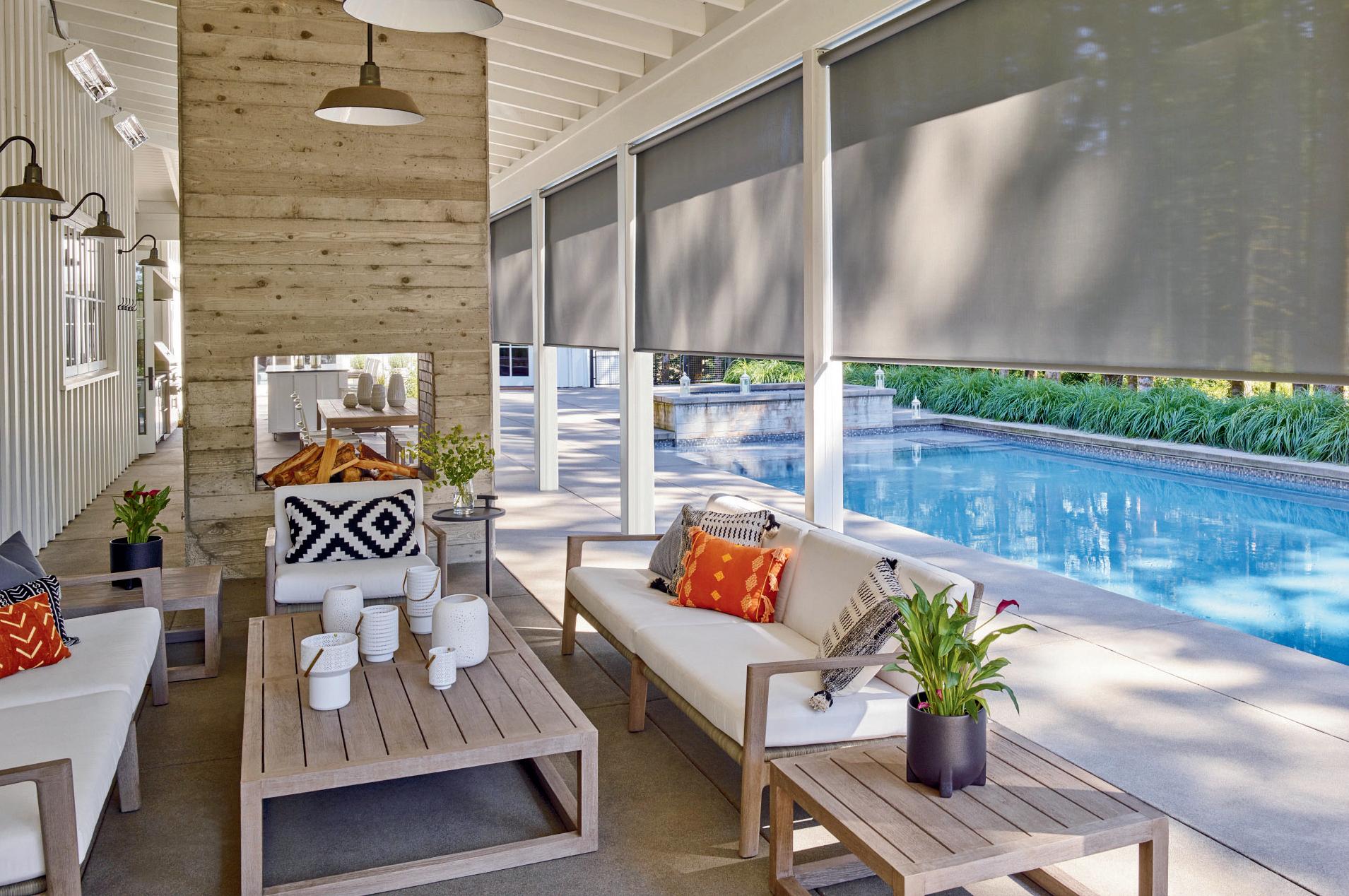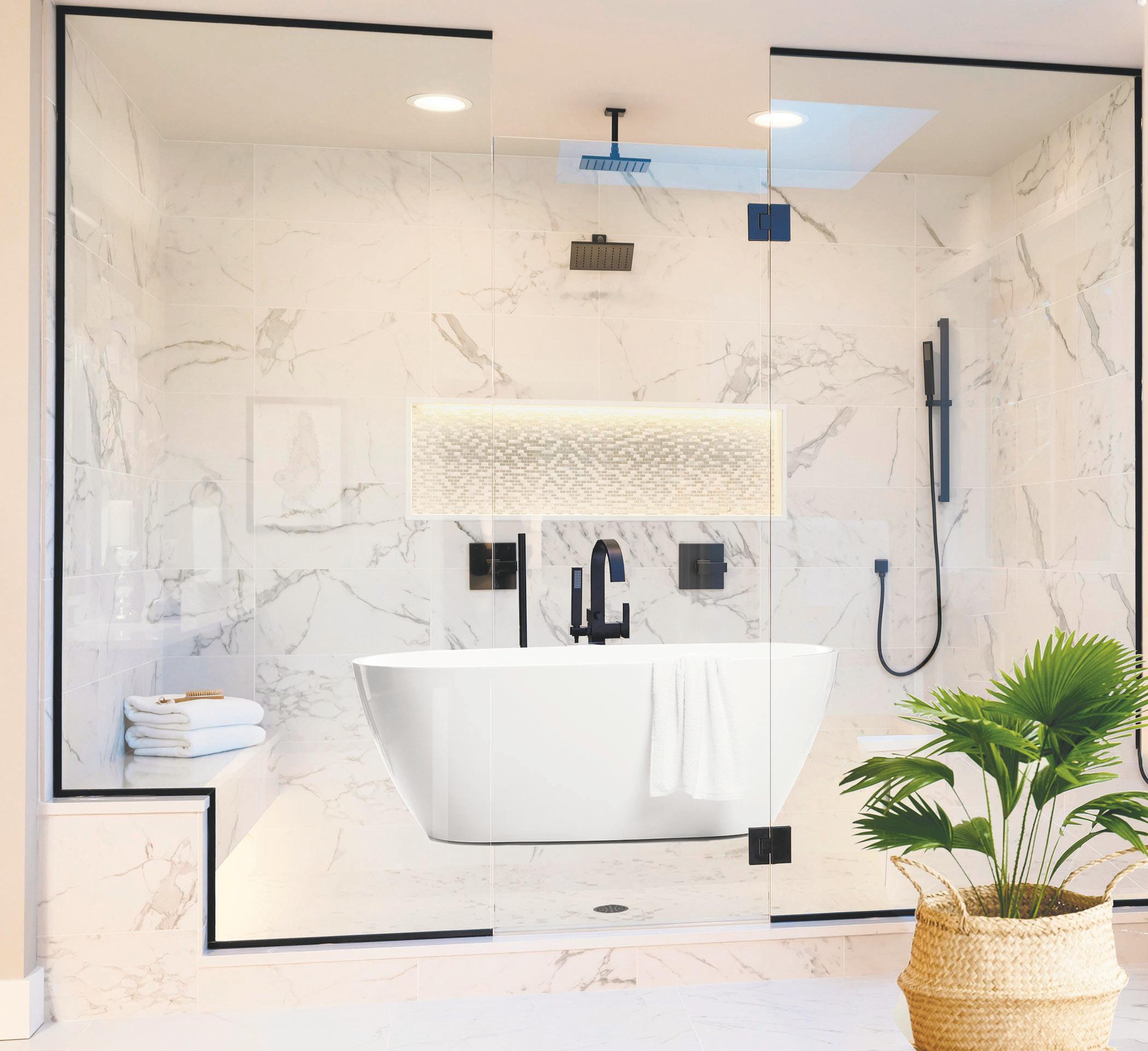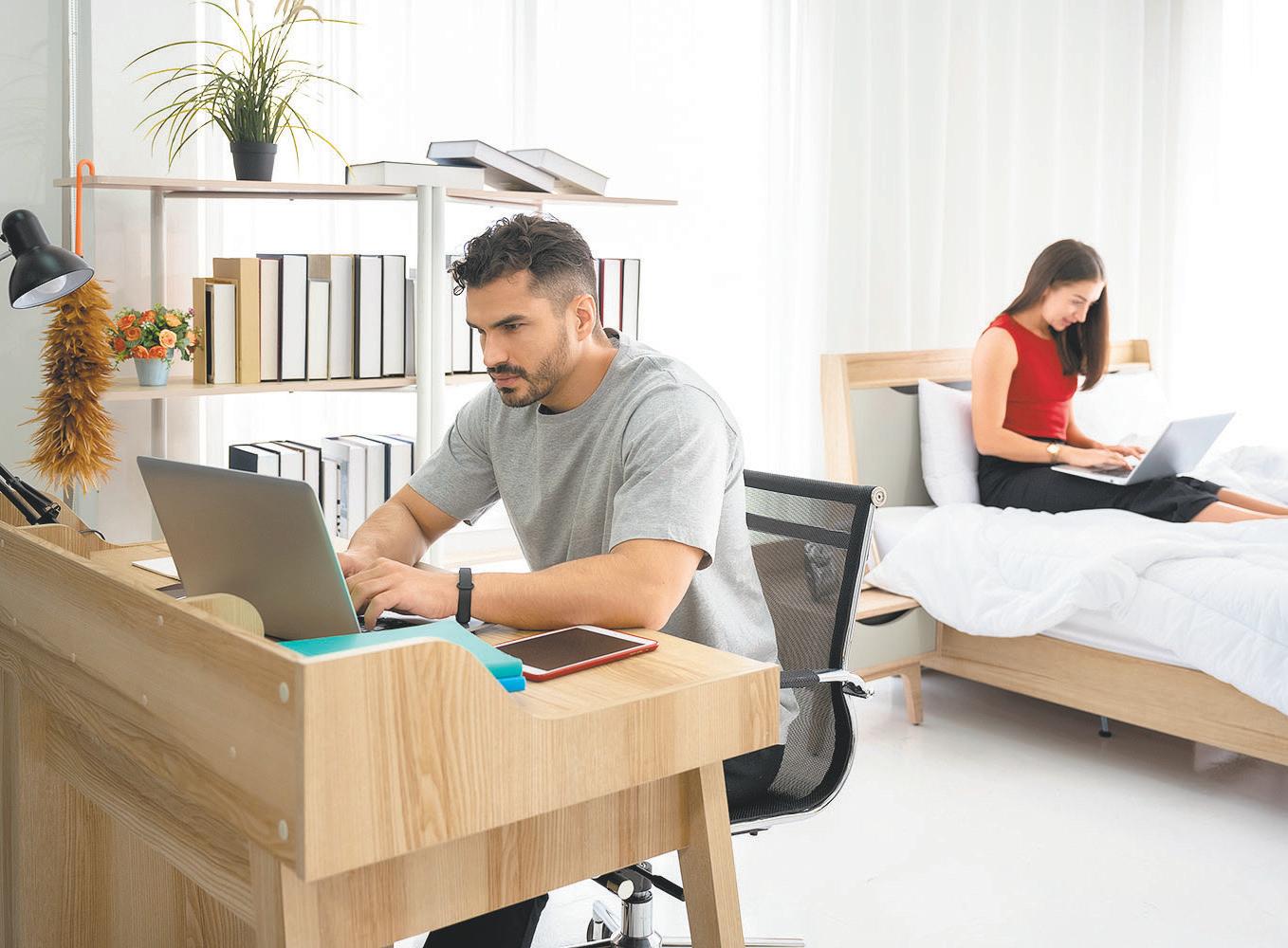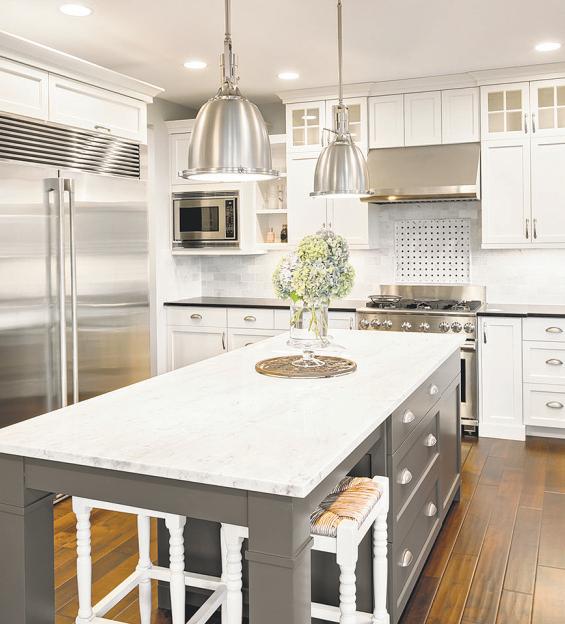Expert HOME MAKEOVER



TIMES TOTAL MEDIA SPECIAL ADVERTISING SECTION





TIMES TOTAL MEDIA SPECIAL ADVERTISING SECTION


Life demands a lot from you. Why not gift yourself a bedroom refresh? After all, more than any other room in your home, your bedroom is all about you. And a good night’s sleep is truly one of life’s ultimate joys.
First of all, is everything where you want it to be? Moving the main pieces around can really give your bedroom new life. Explore different layouts online and see if any “speak” to you. Many of us settle for the layout we achieved when we first moved in; there’s no reason you can’t improve on that. Get some of those furniture moving pads to make it easier.
Once you’re sure of your layout, it’s time to consider the floor. Whether your bedroom’s flooring is wood, tile or wall-to-wall carpet — and especially if it’s seen better days — think in layers. Layer-

gives a feeling of decadent comfort underfoot, while absorbing sound and adding loads of visual interest (whether through colors, patterns or textures). You could start with a large area rug under your bed or an almost-room-size rug that sits about a foot away from the walls. Then add a smaller rug or two, at an angle, wherever it makes visual sense (to protect a higher-traffic area or to define a space like a reading nook). When your mood or preferences change, these smaller rugs can be switched up inexpensively. Each rug protects what’s underneath it
from wear and tear. So while it’s making you feel luxurious and pampered, it’s serving a practical purpose as well.
As for your bed, consider upgrading to a four-poster or canopy bed. When draped in a mix of fabrics you love, a canopy bed becomes an inviting hideaway — your sanctuary — and a judgment-free retreat that’s perfect for unwinding from a demanding day and reclaiming your joie de vivre. Add a trio of ivory battery-powered pillar candles for warmth and romance.
How’s your mattress?
Decades old? Replace it! A new mattress could make all the difference in the quality of your sleep. But if you can’t afford to replace it yet, at least turn it over and around.
Then add one or two plush, quilted mattress covers and/ or a memory foam pad for extra cushioning. Think about your pillows too. (Consider adding hypoallergenic pillow covers while you’re at it.)
Clean, fresh new pillows designed for the way you typically sleep (on your side, back or belly) will make your bed feel fresher and more custom.
In terms of bed linens, how about some 1,500 thread count Egyptian cotton sheets? You can find affordable sheet sets in places like HomeGoods, so there’s no need to pass on this usually pricy luxury. Now for the comforter. Add one of those super plush down or down-blend comforters (the soft popping sound they make when you unfold them is the actual sound of comfort) and a weighted blanket in the winter. Add plenty of pillows — the more that are covered in rich-feeling velvet or faux fur, the better.
The walls…
What about a wall-mounted, remote-control fireplace? It’s a splurge, but nothing else will add such a feeling of romance and “home sweet home.” If that’s not an option, a comparably soothing effect could be achieved with a wall-mounted TV playing Netflix’s “Fireplace for Your Home” (complete with crackling sound effects!). Or hang a large framed print of a scene that calms you. Places like HomeGoods often have a number of large framed prints of varying scenes that are lovely and well-priced.
Other possibilities include an accent wall (with wall molding panels, or covered in shiplap, painted in an eye-catching color, or covered in an irresistible wallpaper or fabric).
The windows…
What’s your preference? If you love a space flooded in natural light, hang white or ivory sheers over the win-
dows. If you select drapes with grommets, you can double up on the sheers for the same amount of light, with a little more privacy. But if you like to sleep in on days off (or every day? No judgment!), blackout drapes might be the answer.
If you have space, add a cushioned storage bench, a pouf, or a velveteen reading chair with a pillow (and a reading lamp).
Do you love the scent of lavender? Plug in an air fresh ener in that scent, which is said to encourage sleep. Eucalyptus or cinnamon are also heavenly.
If you want more space in your bedroom for any of these extras, and it will fit, put your bureau (and jewel-
ry armoire, if you have one) in your closet. Take out all the clothes you never wear anymore (you know there are a bunch) and you’ll have lots more room in there.
Adding risers to your bed will offer space for storage underneath as well. Install a longer bedskirt to cover all that, and voila! Let the therapy begin in 3…2…1….
Sources: thespruce.com, mydomaine.com, netflix .com, wayfair.com



Times Total Media is the sales and marketing division of the Tampa Bay Times. Contact timestotalmedia@tampabay.com with questions.



Is it time to reimagine the rooms in your home?
Level up your abode by adding color, color, color. Paint in a panoply of hues can improve your space and give it a fresh face. Not only that, but the colors you choose may have an impact on your mood. Read on for a mini master class on color theory to help you decide which colors to incorporate into your home and which to leave on the palette.
“Color theory is the study of how colors work together and how they affect our emotions and perceptions,” writes the Interaction Design Foundation. While we may not always be conscious of how the colors around us affect us every day, it’s important to pick the right ones for you and your home. According to Mental Health America, “while more research is needed to fully understand the links between color and mood, color theory suggests that carefully selecting the color scheme for your home can positively impact your mental health and well-being.” So, which
colors should you pick?
If you’ve ever heard the expression “seeing red,” it’s for good reason: Red can symbolize feelings of passion or anger. According to Mental Health America, red is associated with both higher blood pressure and a higher heart rate, plus faster respiration. Because it’s so potent, it’s best to incorporate red in places that are engaging or see a lot of activity, like an entertainment room or your kitchen.
A bit quirky, orange is typically chosen as people’s least favorite color, according to Science of People, but why should that stop you? Stand out from the crowd with this fun-loving color that can increase your appetite and energy levels, per Mental Health America. Like red, it’s best in rooms of activity, like the kitchen or your at-home gym.
Perfect for the Sunshine State, yellow is your sunny
ticket to feelings of cheeriness and joy. Because it packs a punch, it’s best in small doses and can be anxiety-inducing in large amounts, writes Mental Health America. If you do opt for yellow, consider using it in rooms that may be smaller, such as your bathroom or kitchen, or opt for yellow accents, like pillows or blankets, instead.
Evoking feelings of nature, peace and growth, green is considered the most balanced color and can improve your mood when you’re feeling upset, writes Mental Health America. Incorporate it into your bedroom, living room, sun porch or, if you’re not ready to go all-in on green walls, cultivate a collection of plants throughout your home instead to still reap green’s great benefits.
If you’re looking for a soothing color to paint your bedroom, blue may be your best bet. According to Science of People, “a study of 2,000 homes found that people
who sleep in blue rooms get more sleep than (those) in other colored rooms.” As a calming cool color, blue can even lower your heart rate and blood pressure, says Mental Health America.
For a room fit for royalty, pick purple. Purple, often associated with creativity and imagination, may be a good choice for your at-home office to keep you inspired all workday long. According to Mental Health America, purple can even enhance your senses and self-awareness. It’s a great choice for your bedroom or living room and can bring a punch of playfulness to your everyday spaces.
It may be seen as basic by some, but white walls certainly have their place in your home: White is associated with calmness and cleanliness and can be a great backdrop for the other colorful accents and artwork in your home. It’s great anywhere, just be careful not to go overboard on too much of it: According to Mental Health America, too much white can feel lonely or sterile.
Sources: interaction-design .org, mhanational.org, very wellmind.com and science ofpeople.com.


Have you been thinking about replacing your home’s roof? Now might be the perfect time to change the look, energy efficiency and functionality of your roof altogether. Why? Because new roofing trends incorporate features and materials that make your home cooler, smarter (really!) and more energy-efficient.
According to Forbes Home, “Solar shingles, or solar roof tiles, are made of slim photovoltaic (PV) sheets that either overlay or replace the existing shingles on a roof.” These are a sleek and almost seamless alternative to traditional solar panels. Designed to look like regular shingles or tiles, they blend in with the roof while generating electricity. Modern solar roofing materials are built to withstand harsh weather conditions, often featuring strong warranties. Their lifespan is typically around 25-30 years, or more; regular cleaning (once or twice a year) helps ensure maximum efficiency and lifespan.
Compared to solar panels, solar shingles take more time to install (one to two weeks), and, unlike solar panels, their angle can’t be adjusted. Their energy production is not as great as that of panels, but you can increase energy production by adding more shingles. Solar shingles create a sleeker aesthetic than bulky
solar panels, particularly since only parts of the roof, like the edging, need to be covered in shingles to be efficient. Depending on the size of your roof, your energy needs and the manufacturer and installer, pricing can range from $15,000 all the way to $70,000.
Imagine a roof that optimizes energy use, monitors and adapts to weather conditions or alerts you to maintenance needs before they become a wallet-busting crisis. This is the idea behind smart roofing. Smart roofing can incorporate one or more of these features:
• Insulated roof panels
Benefits: Heat and noise reduction, lower maintenance, 40-year lifespan.
• Solar shingles
Benefits: They generate electricity from sunshine while they visually blend in with your roof.
• Smart sensors
Benefits: They monitor weather changes like rainfall, wind direction and temperature; they monitor structural strain and signs of damage; they’re like a “check engine” light for your roof.
Cool roofing technology
As global warming continues and energy prices keep

rising, the advantages of a cool roof cannot be overstated. As the materials are about the same cost, the process is most cost-effective when installing a new roof or roof replacement; but there are (post-market) coatings that can be applied to your existing roof that will bring similar benefits.
Designed to reflect more sunlight than a conventional roof, a cool roof absorbs less solar energy, and less of that heat reaches your interior, keeping you cooler and putting less strain on your HVAC, which will enable it to last longer. Rooftop temperatures on a conventional roof during a hot summer day can reach 150 degrees; however, a properly installed cool roof in the same conditions will read around 90 degrees. The reduction in “baking” can extend the life of the roof as well. This also results in a reduction in peak electricity demand, which can prevent or reduce outages.
A bonus: When enough people in an area have cool roofs, they can actually lower outside temperatures around them and reduce smog from heat-dependent air pollutants.
Sources: americanweather star.com, awipanels.com, coolroofs.org, energy.gov, premiergrouproofs.com, roofstampa.com, stalbert gazette.com and storhy.net.


























From Consumer Reports:
“A 2022 Associated Press study found that climate change-induced wildfires, hurricanes and ice storms have doubled the number of U.S. power outages over the past 20 years. In 2021, the last year for which data are available, the average electrical outage in the U.S. increased to 5.5 hours from a little more than three hours in 2013, according to the U.S. Energy Information Administration. Hurricanes, ice storms and other weather events were largely to blame.”
Every spring, homeowners in our neck of the woods start thinking about hurricane season, and thoughts often turn to generators. Would a whole home generator be a wise investment?
Maybe. The answer depends on a number of factors — how much you are willing to spend or finance, the size of your home, whether you rely on medical equipment
that has to stay powered and whether you live in a flood-prone area (which might preclude installing a unit that can’t be moved).
What do you want it to cover? If you’re only interested in powering your HVAC system, a portable 20kW generator might be the best option. Upgrading to a 24kW will allow you to power the refrigerator and HVAC unit simultaneously. Or, you can go for a true whole home generator – between 38kW and 40kW – and you’ll have enough electricity to keep an entire 3,600-square-foot house powered up. And thanks to the automatic transfer switch, the transition will be almost instantaneous, without you having to lift a finger.
Installing a whole home generator is a job for licensed professionals; it is not a weekend DIY. You will need a concrete pad installed in the proper location, as well as a professional tie-in to your circuit breaker, and a secure connection to a

natural gas or propane line.
(FYI: Large propane tanks can be installed out of sight underground, and their propane levels can be monitored via remote.) Every aspect of the installation will need to be compliant with local codes and regulations.
After install, you can link your standby generator to a smartphone app for information on everything from equipment functionality to maintenance alerts.
Here’s a breakdown of approximate price ranges based on generator size:
These generators typically cost between $2,000 and $5,000 for the unit alone. Installation costs can vary de-
pending on factors such as electrical work, permits and fuel line installation, but they might add another $2,000 to $5,000 to the total cost.
generators (20-45 kW):
These generators can range in price from $5,000 to $15,000 for the unit alone. Installation costs for these larger units can be higher, potentially ranging from $5,000 to $10,000 or more.
Generators in this size range can cost upwards of $15,000 for the unit alone, with installation costs potentially reaching $10,000 or more.
Keep in mind that these are rough estimates, and prices can vary based on factors such as brand, features (such as automatic transfer switches and remote monitoring), fuel type (natural gas, propane or diesel), location and local labor rates.
Additionally, ongoing maintenance costs, fuel expenses and any necessary accessories or upgrades can also contribute to the overall cost of owning and operating a standby generator.
Yes, the prices are up there. But only you can know if your peace of mind is worth that price. For many folks in hurricane country, it definitely is.
Before purchasing a standby generator, it’s recommended to get quotes from multiple suppliers and consider consulting with a professional electrician or generator installer to assess your specific needs and budget. They can help you choose the right generator size and model for your home and provide guidance on installation and typical maintenance requirements.
Sources: consumerreports .com, generac.com, genera torsupercenteroftampa.com, justenergy.com, kohlerhome generators.com, leecompany. com, mrelectric.com, stansac .com, chat.openai.com
You could call them bathrooms without borders. And they’re growing in popularity.
In this type of bathroom, everything’s out in the open, easily accessible and tiled or otherwise waterproofed, with no need for glass walls or separations (unless you want them). The sleek and ultra-modern look is big on the wow factor, with a luxury spa feeling. Practically speaking, wetrooms add value to your home, are far easier to clean and their accessibility is a major advantage for people with mobility issues.
Instead of a cubicle with a space-hogging door for the shower, perhaps one glass wall or a vertical half wall is all you need. Plus, this could be the time when your dream of a rain showerhead in the ceiling can finally become a reality. These and other design features make this type of bathroom particularly adaptable to tighter spaces. And no worries; with the right features, layout and placement, towels and toilet paper are well out of reach of shower spray. As for the floor,


which is likely to be one level surface, go with a textured, slip-resistant tile to eliminate any worries about slipperiness. (If you’re still concerned, add in-floor heating, which dries water droplets more quickly.)
Next, a wall-mounted toilet (and bidet?), some teak wall shelving, grab bars wherever you want them, a floating vanity with towel cubbies and a dramatic mirror and voila! You have a sleek, ultra-posh bathroom that’s also safe, accessible and functional.
To help you visualize what’s possible, check out some of these minimalist designs.
Sources: build.com, cclwetrooms.co.uk, hgtv.com, houzz.com, inspiredbath roomsandkitchens.com, redfin.com, thespruce.com.
“There are so many options available if you want easier access in your bathroom. Consider a wide-entry barrier-free shower, handheld sprayers at different levels, flip-up seating, hand-held shower cradles, and well-placed grab bars. Those who prefer tub bathing but have mobility issues can opt for a walk-in tub with either deep tissue water jets or the more gentle massaging air jets, along with a hand-held shower.”
-Dave Klinger, Luxury Bath Tampa Bay, Palm Harbor

Your spare room called, and it wants a makeover. If your current setup just isn’t cutting it, start anew: From a personalized home office to a home theater for streaming your favorite flicks, embrace these six suggestions for transforming the extra room in your home into something practical, magical or both. Off you go!
Plant room: If you’ve got a green thumb and more plants than you know what to
do with, consider creating a plant room. Plant stands with shelving will be your best friend here, allowing you to display your leafy companions while saving on space. Add some ceiling hooks to accommodate hanging plants, but be sure you position your plants properly, so they get the right amount of light. Throw in some sparse furnishings alongside your plant babies, such as a reading chair, a small table or even an oversized pouf, so you can dwell amongst your indoor garden.

Home gym: Take your training to the next level in your own home gym. What you add to it depends on your favorite form of fitness. The options are endless: You could incorporate a weight bench, a


stationary bike, a punching bag, a treadmill, a yoga mat or, depending on how much space you have, all of the above. Install a sound system to play your favorite motivating workout jams during your next sweat session.

You can also incorporate a cooldown corner: Include space for stretching, hydrate with your own personal water cooler or stock a mini fridge with your favorite healthy post-workout snacks and beverages.
Art studio: If you’ve got a creative side, turn your spare room into an art studio. Whether you’re creating cartoons, clay sculptures, oil paintings or your own handcrafted jewelry, you’ll want to purchase a sturdy desk that will give you enough space to make your creations. Buy a bulletin board for hanging
inspiration images, or tack ’em straight to the wall. Don’t forget to purchase a storage shelf or rolling cart to hold all your art supplies. You’ll want everything you need
Home office: One of the best parts of working from home is that you get to customize your home office however you’d like. So, don’t be shy: Does music motivate you? Purchase a record player or sound system and place it near your desk. Put up artwork that inspires you and choose a color palette for the room that you resonate with. A wire desk organizer can

organized and within reach, so nothing slows down the creation of your next masterwork.
help hold your office supplies and keep your desk tidy, and you can’t go wrong with a good statement lamp.
Most importantly, you will be spending hours in your office each day, so make sure to invest in a comfortable, ergonomic chair. You can find plenty of options on Amazon.
machine (find one for under $250 at Home Depot) or install a shelf to hold your favorite movie theater-approved candies. That’s a wrap!


Home theater: If you’re a cinephile at heart, turn your spare bedroom into a home theater for viewing all of your favorite films. (“The Village,” anyone?) Make your motion picture dreams a reality with a large projector screen, a sound system and theater-worthy comfortable seating, among other considerations. You may also want to make efforts to soundproof the space. “Even if wall-to-wall carpeting isn’t your thing, you’ll love it for your home theater since it reduces audio-bounce,” advises The Spruce. Don’t forget the snacks: Add in a popcorn

Hybrid room: Can’t decide how to use your space? Create a hybrid room instead. A guest bedroom with a desk in the corner could function as your home office during the day. A room full of both your plants and your partner’s vintage collectibles could function as a collector’s room with a botanical twist. Or, in the end, you may decide that your spare room would function perfectly as extra storage space for you and your family. The options are endless –and entirely up to you!
Sources: thespruce.com.




Springtime is here, and with it, beautiful Florida weather that beckons us all outside. What better time to transform your backyard space into a serene oasis equipped for relaxation by day and entertaining guests by night? We’ll help make it happen: Step into spring with our top suggestions for creating an outdoor living space that you and your family will love.
Perfect your patio:
Bring the comforts of the indoors outside with a patio space designed to wow. First, add some furniture. Patio furniture, from outdoor sectionals to comfortable chairs, can come in an array of styles and materials. Make sure you choose the furniture that’s right for your space, especially if it isn’t covered. “Regular cleaning (for outdoor furniture) is necessary regardless of the material, but materials like aluminum and recycled plastic require little to no
additional care. Materials like wood, wrought iron and wicker tend to age faster and react more to the outdoor elements,” writes PatioLiving.
To stay shaded, consider covering your patio space with a covered pergola, a canopy tent or even a hardtop gazebo. (Some gazebos may even come with seating and a table space built in, saving you the trouble of purchasing patio furniture.) Add a punch of personality with an outdoor rug and pillows in your favorite colors and patterns and consider investing in outdoor storage bins or sheds to hold gardening tools, a volleyball net to hang when friends fancy a game or anything else you’d like to have handy when you’re enjoying the great outdoors.
Don’t forget food: Elevate your outdoor space with an outdoor kitchen. “Popular designer outdoor kitchen features include bars with sinks,

grills that rival any indoor cooking range, appliances such as stainless steel refrigerators, cabinets, grill islands and luxurious countertops – putting within reach everything to make a delicious meal (or the perfect beverage) alfresco,” writes HGTV. The options don’t end there: Make mealtime mouthwatering with an outdoor pizza oven or procure an outdoor freezer to hold your favorite pints of Ben & Jerry’s. You can thank us later.
Add color with decorations and landscaping:
Once you have your main outdoor living space set up, it’s time to add embellishments. These can be functional assets to your new space, purely aesthetic items or a combination of the two. You could buy string lights to
your new gazebo, purchase citronella tiki torches to keep bugs away, create a butterfly garden space nearby to add pops of pretty florals to your landscape, include a flowing fountain for beautiful ambient sound or find space for a fire pit for you and your guests to enjoy. The options are endless.
Invest in a swim spa:
What’s missing? A place to enjoy water activities! Can’t decide between installing a pool or springing for a hot tub for your backyard? Now you don’t have to. Swim spas from Clearwater-based
mainstay Spa Manufacturers, Inc. have enough space for pool lovers to swim in place or exercise while also providing heated water, jets and a seating area that hot tub aficionados enjoy. Spa Manufacturers’ swim spas, which are available in both portable and in-ground models, start at $9,995, with more expensive deluxe versions offering additional add-ons, from LED lights and a waterfall feature to an attached bar with bar stools for outdoor entertaining. “(Our swim spas are) super easy to clean and take care of, so they’re low maintenance,” said Sheryl Harrell, a sales associate at Spa Manufacturers. Visit spamanufacturers.com to learn more.
Sources: patioliving.com and hgtv.com.






